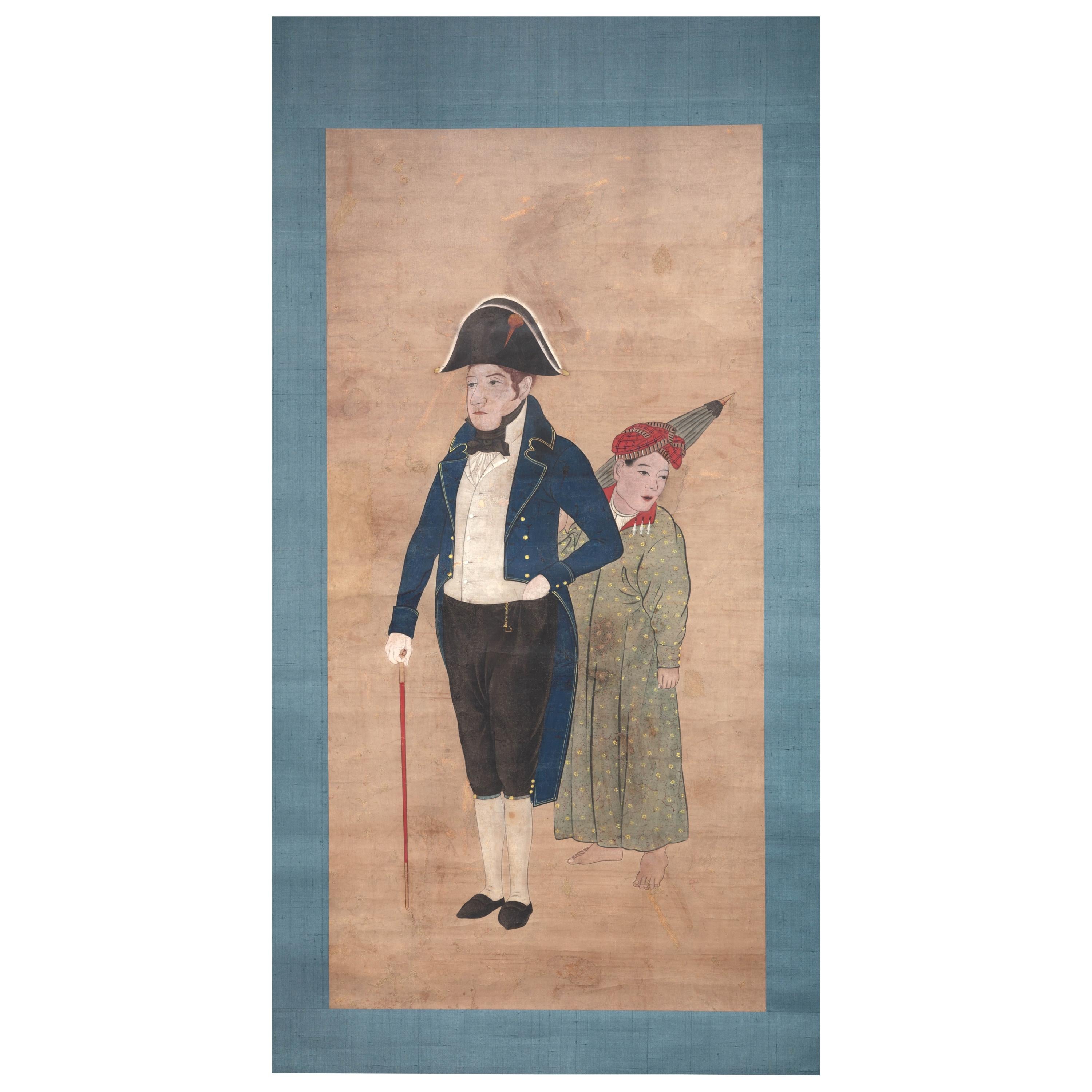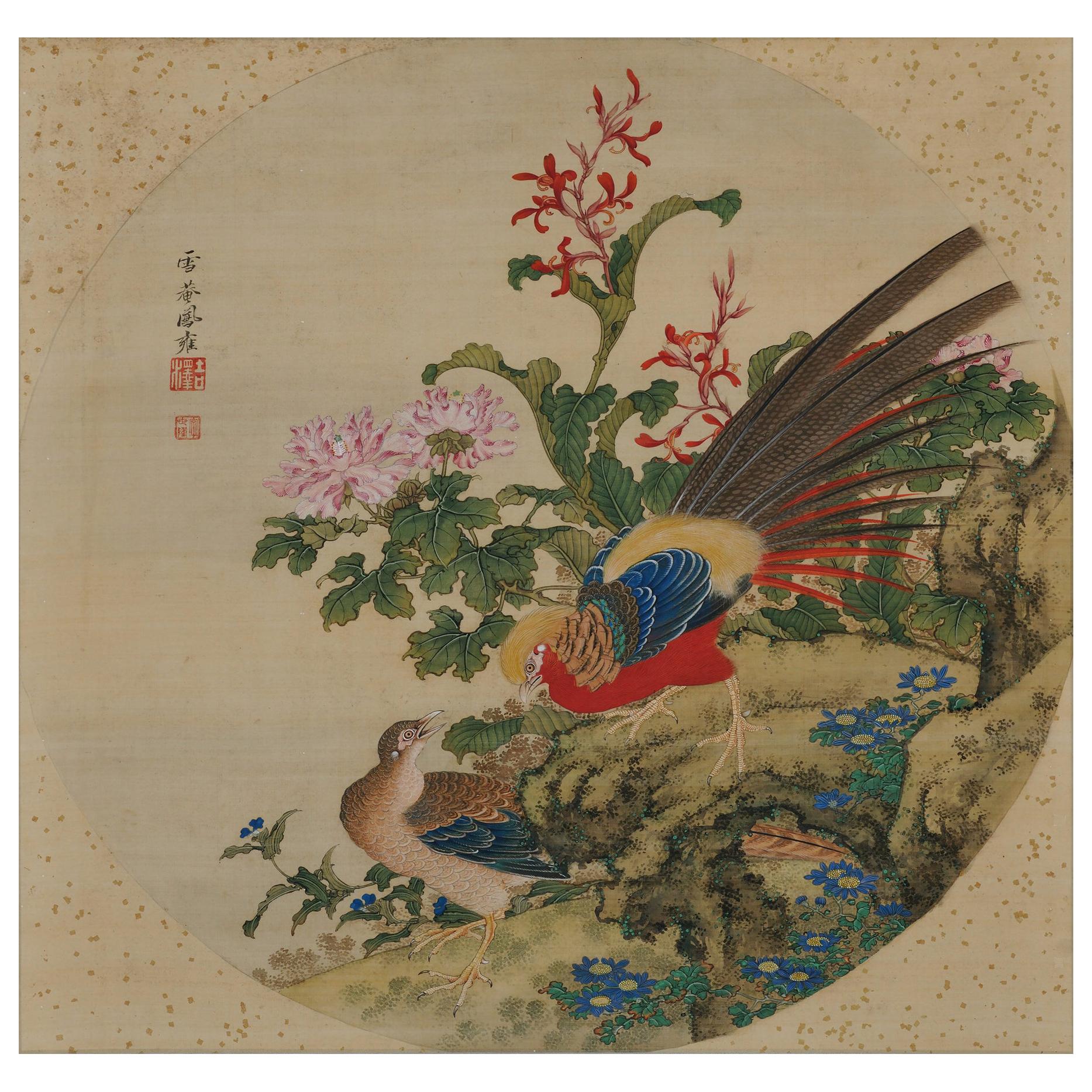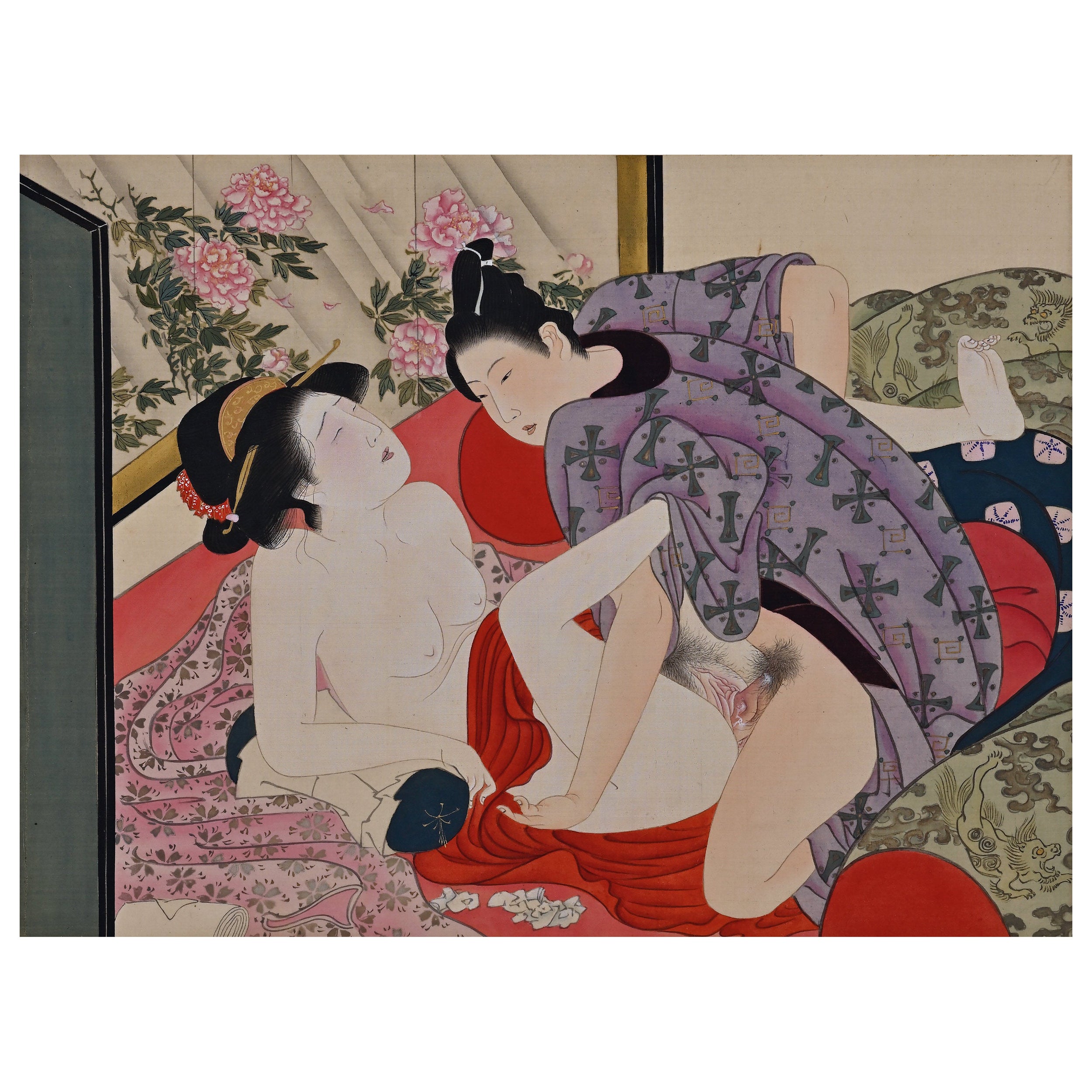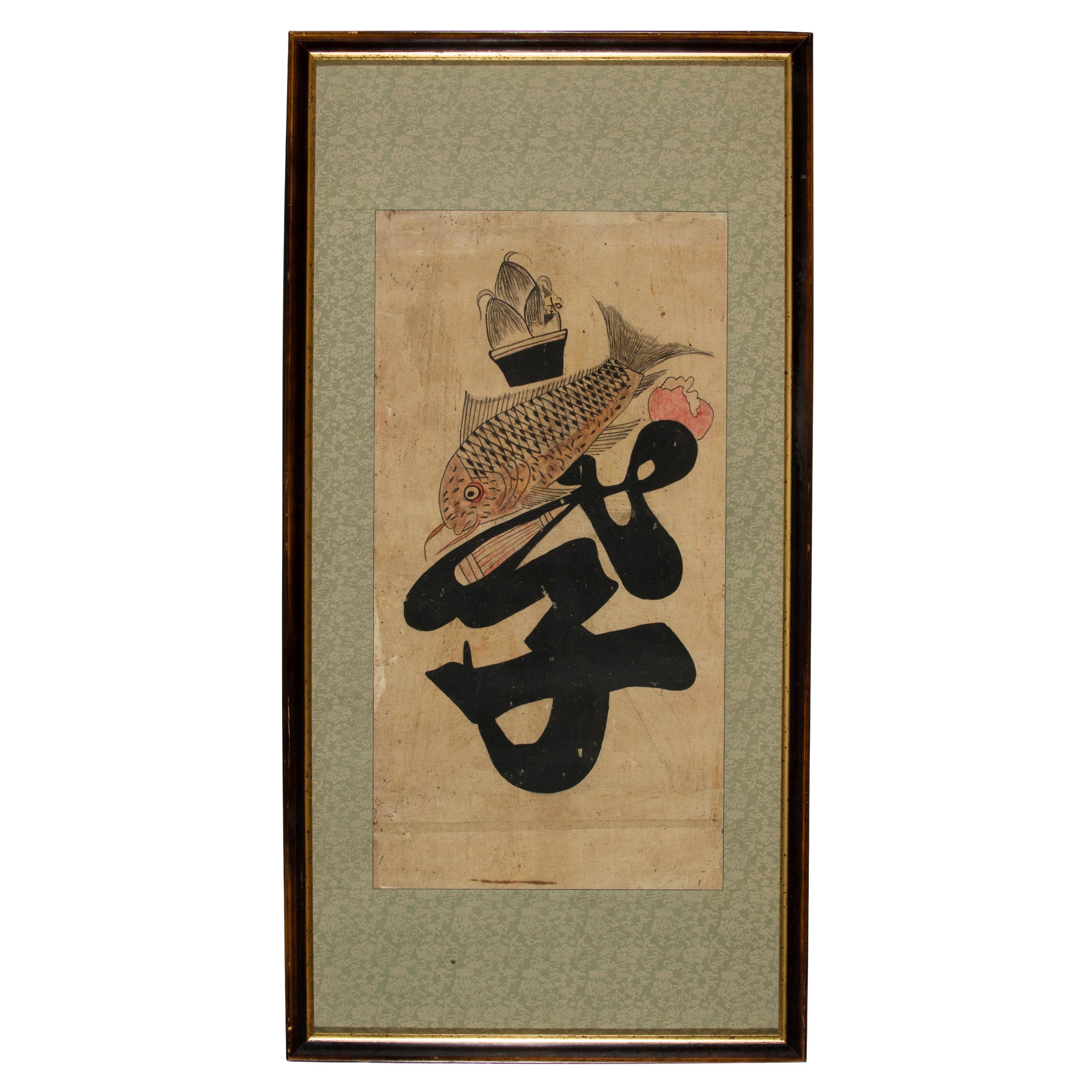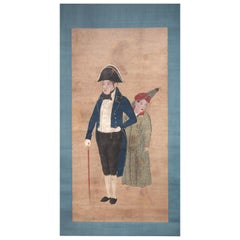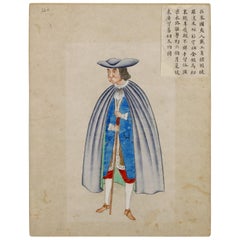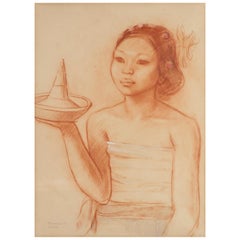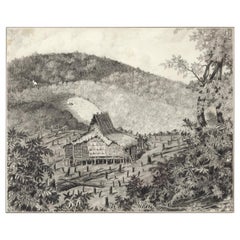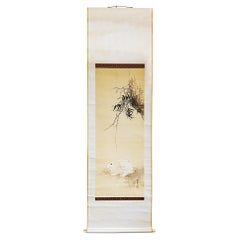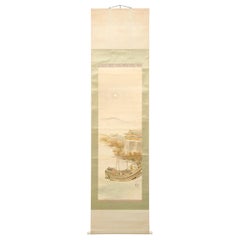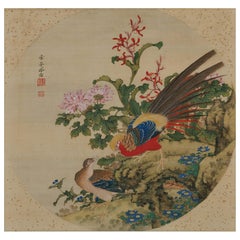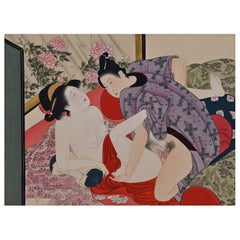Items Similar to Japanese Scroll Painting of Diplomat Takeaki Enomoto, Meiji, Late 19th Century
Want more images or videos?
Request additional images or videos from the seller
1 of 2
Japanese Scroll Painting of Diplomat Takeaki Enomoto, Meiji, Late 19th Century
About the Item
Anonymous Japanese painter (MEIJI PERIOD, LATE 19TH CENTURY)
Portrait of Takeaki Enomoto (1836-1908)
Ink, color and go fun on silk, framed.
Painting: 79.5 x 50 cm
With frame: 103.5 x 64.5 cm
Note:
Takeaki Enomoto, a Meiji government official, is painted in very fine detail standing next to a Chinese style table upon which a globe, painted in white gofun and a book bearing a coat of arms. He is wearing a western frock coat and holding a cane. Takeaki Enomoto was a ket player in the events which led to the establishment of the Meiji government. He also made a significant contribution to Japan’s relations with the West in the late 19th century. He was born as a lower-ranking samurai, but rose up to hold various important posts in the Edo period government. Enomoto studied Dutch naval science in Nagasaki, which during the Edo period was the only city in which the Dutch on the small artificial island Deshima, were permitted to stay and trade. He then continued his studies in Holland from 1862, and became fluent in Dutch and English. In 1867 he returned to Japan and was appointed to a senior naval post in the Tokugawa bakufu (government). However, in 1868, the Tokugawa bakufu was overthrown by the warlords of Satsuma and Choshu, and the Meiji Emperor was reinstated as the figurehead of a new government.
Enomoto resisted the takeover of the Meiji government by fleeing with eight warships to Ezo (Hokkaido) and establishing a Tokugawa “republic” as the last military stronghold opposing the new regime. In spring 1869 Enomoto surrendered and peace was officially restored to the whole of Japan. When he surrendered Enomoto sent the notes he had made on navigation in Holland to the commander of the army, stating that they would be useful for the country. This conduct impressed the Meiji government and therefore he was imprisoned rather than executed. In 1872 he was pardoned and immediately appointed to office in the government. He was sent to St. Petersburg as a diplomat to negotiate over the ownership of Sakhalin and Kuril islands. He was successful in concluding a treaty giving Sakhalin to Russia but keeping the Kurils for Japan.
His achievement was celebrated as the first in which Japan and a Western power were treated as equals. Enomoto rose to cabinet rank within the Meiji government and his positions included that of the Minister of Agriculture and Commerce. The globe and book here are clear references to Enomoto’s international experience.
The book bears a coat-of-arms with notable similarities to that of Napoleon III (1808- 1870). During Enomoto’s time in the Tokugawa government negotiations between France and the Shogunate began. The first French military mission to Japan, sent by Napoleon III, arrived in 1867. With the mission came Captain Jules Brunet (1838-1911) a military officer who joined the last stand of the Shogunate “republic” in 1868 by fleeing north with Enomoto to Ezo.
- Dimensions:Height: 40.75 in (103.5 cm)Width: 25.4 in (64.5 cm)Depth: 0.79 in (2 cm)
- Style:Meiji (Of the Period)
- Materials and Techniques:
- Place of Origin:
- Period:
- Date of Manufacture:1880-1900
- Condition:Wear consistent with age and use.
- Seller Location:Amsterdam, NL
- Reference Number:1stDibs: LU5458220980532
About the Seller
5.0
Recognized Seller
These prestigious sellers are industry leaders and represent the highest echelon for item quality and design.
Established in 1985
1stDibs seller since 2020
23 sales on 1stDibs
Typical response time: 1 hour
- ShippingRetrieving quote...Shipping from: Amsterdam, Netherlands
- Return Policy
Authenticity Guarantee
In the unlikely event there’s an issue with an item’s authenticity, contact us within 1 year for a full refund. DetailsMoney-Back Guarantee
If your item is not as described, is damaged in transit, or does not arrive, contact us within 7 days for a full refund. Details24-Hour Cancellation
You have a 24-hour grace period in which to reconsider your purchase, with no questions asked.Vetted Professional Sellers
Our world-class sellers must adhere to strict standards for service and quality, maintaining the integrity of our listings.Price-Match Guarantee
If you find that a seller listed the same item for a lower price elsewhere, we’ll match it.Trusted Global Delivery
Our best-in-class carrier network provides specialized shipping options worldwide, including custom delivery.More From This Seller
View AllDutch Colonial Japanese Scroll Painting of Chief Merchant Doeff
Located in Amsterdam, NL
Nagasaki School (EARLY 19TH CENTURY)
Opperhoofd Hendrik Doeff with Javanese servant
Kakemono, watercolor on paper, mounted on silk and textile covered paper scroll, not signed....
Category
Antique Early 19th Century Japanese Edo Paintings and Screens
Materials
Silk, Paper
Five Extremely Rare Chinese Drawings of Foreigners, 18th Century, Colonial
Located in Amsterdam, NL
Five Chinese paintings of western people by an unknown artist
China, circa 1760, captions later
All in giltwood frames.
“A woman with Portuguese hairdo, with gold, silver and gemstone necklace, a skirt under a vest, a koi on her back, called a cloak, a woman customarily inherited the family business, the male humble, to the threshold (Qianlong year, circa 1735).”
Gouache on silk, measures: 32 x 25.4 cm
“He is a Westerner who had a white skin. He does not have a heavy beard but plaits his hair. He wears a triangular black hat, short jacket, leather shoes and long stockings...
Category
Antique Mid-18th Century Chinese Chinese Export Paintings and Screens
Materials
Paper
Portrait of a Balinese Beauty by Theo Meier in Original Frame
Located in Amsterdam, NL
Theo Meier (1908-1982)
“A Balinese woman with offerings”
Signed, dated '36 and annotated Mankok (the name of the sitter) lower left
Sanguine on paper, measures: 57 x 41.5 cm
In a handmade and hand painted frame with address: Max Kno¨ll, Herberggasse 4/1, Basel.
Provenance:
Private collection, Basel (acquired directly from the artist)
Private collection, London
Note:
Theo Meier was born in Basel, where he attended art school and became a successful portrait painter. However, after visiting an exhibition in Basel of Tahitian paintings by Paul Gaugin, he decided to follow in Gaugin’s footsteps and go to the South Pacific. To finance his voyage, he founded a club in which every member pledged a monthly sum in return of which they could choose one of Meier’s paintings upon his return.
In 1932, at the age of 24, he embarked on his voyage to the South Sea. In Tahiti, he certainly discovered the beauty of the colours of the tropical world but the simplicity of the inhabitants, he had seen in Gaugin’s paintings turned out to be more in the artist’s fantasy than in reality. He returned to Basel but in 1935 again was on his way to the South Sea. In 1936 he arrived in Bali, planning to stay there for two or three weeks, but thirty years later he was still there. In Bali “a delirium laid hold of me which even today has not subsided”, he was to write much later. The present drawing was made during his first “delirius” year in Bali. In Bali, he settled and found inspiration and friendship with other artists including Walter Spies...
Category
Early 20th Century Balinese Dutch Colonial Paintings and Screens
Materials
Other
Collection of Colonial Drawings Depicting Indonesia by J.G. Sinia '1875-1948'
Located in Amsterdam, NL
A Collection of Thirteen Ink and Chalk Drawings by Johan Gerard Sinia (1875-1948)
All framed in gilt-metal or giltwood frames
Sinia started his professional career as an army off...
Category
Early 20th Century Indonesian Dutch Colonial Paintings and Screens
Materials
Other
$28,988 / set
Free Shipping
Fine Mughal Painting of a ‘Lion at Rest’, North India, Early 19th Century
Located in Amsterdam, NL
A Mughal painting of a ‘Lion at rest’
North India, early 19th century
?
Watercolour on paper, H. 46.5 x W. 68 cm
?The present painting is a large...
Category
Antique Early 19th Century Indian Paintings and Screens
Materials
Paper
A Japanese painting depicting two European generals
Located in Amsterdam, NL
Nagasaki, 19th century
H. 98 x W. 41 cm
Provenance:
Private collection, Portugal
Category
Antique 19th Century Japanese Paintings and Screens
Materials
Paper
You May Also Like
Japanese Hanging Scroll, Late 19th Century
Located in New York, NY
A Japanese hanging scroll or Kakejiku, circa 1890, depicting bamboo grass and a rabbit, framed by top and bottom ribbons of brocade silk.
In ...
Category
Antique 1890s Japanese Meiji Paintings
Materials
Silk, Paper
$2,624 Sale Price
20% Off
Japanese Meiji Riverside Scroll Painting, c. 1900
Located in Chicago, IL
Although western painting was initially embraced during Japan’s Meiji period (1868-1912), artists brought on a revival of traditional painting styles as they sought to create a modern Japanese style with roots in the past. This exquisite hanging scroll demonstrates the preference for soft layering of gray tones with judicious use of color. The landscape is rendered in soft ink washes that subtly distinguish between water, mountain, and sky. The scroll painting...
Category
Early 20th Century Japanese Meiji Paintings and Screens
Materials
Paper
Japanese Scroll Painting, 19th Century Chinese Pheasants by Yoshizawa Setsuan
Located in Kyoto, JP
Chinese Pheasants
Yoshizawa Setsuan (1809-1889)
Hanging scroll, ink and color on silk.
Painting inscription: Setsuan Houyou
Upper seal: Y...
Category
Antique Mid-19th Century Asian Meiji Paintings and Screens
Materials
Silk
19th Century Japanese Shunga Hand-Scroll, Katsukawa School
Located in Kyoto, JP
Shunga
Unknown artist
Meiji era, circa 1880
Hand-scroll mounted with 12 paintings
Ink, pigment and gofun on silk
Dimensions:
Each image measures H. 23.2 cm x W. 34.4 cm (9.15” x 13.5”)
The hand-scroll measures H. 28 cm x W. 540 cm (11” x 212”)
A set of 12 late 19th century Japanese Shunga paintings mounted as a hand-scroll. Two of the leaves bear the signature and seal ‘Setsuzan’, although we are unable to confirm the identity of the artist using this art name. 6 of the 12 images are taken almost directly from Katsukawa Shuncho’s late 18th century woodblock series, ‘Erotic Pictures...
Category
Antique Late 19th Century Japanese Meiji Paintings and Screens
Materials
Silk
19th Century Oriental Ink on Paper Drawing
Located in Roma, IT
Important framed 19th Century oriental ink on paper drawing
Ideograms were often accompanied by images of animals and objects, but sometimes also articulated compositions.
A carp j...
Category
Antique Late 19th Century Chinese International Style Drawings
Materials
Wood, Paper
19th Century Japanese Shibayama Lacquered Inlay Charger, Meiji Period
Located in London, GB
19th Century Shibayama Lacquered Inlay Charger, Meiji Period, Japan
A decorative 19th Century Japanese charger beautifully depicting herons and pi...
Category
Antique Late 19th Century Japanese Meiji Decorative Art
Materials
Bone, Mother-of-Pearl, Lacquer
Recently Viewed
View AllMore Ways To Browse
Japanese Late Meiji
Dutch Japan
Scroll Book
Emperor Japan
English Japanese Style
Portrait Scroll
Antique Japanese Book
19th Century French Screens
English Century Screens
Antique Table Screen
Meiji China
Springer Scroll
Meiji Period Japanese Screen
Antique Japanese Scroll Painting
Japanese Screen Table
Chinese Japanese Scroll
Japanese Silk Painting Ink
Table With Coat Of Arms

